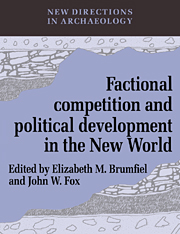Book contents
- Frontmatter
- Contents
- List of figures
- List of tables
- List of contributors
- Preface
- PART I INTRODUCTION
- PART II CHIEFDOMS
- PART III STATES
- 7 Ethnicity and political control in a complex society: the Tarascan state of prehispanic Mexico
- 8 Ethnic groups and political development in ancient Mexico
- 9 Factional divisions within the Aztec (Colhua) royal family
- 10 Alliance and intervention in Aztec imperial expansion
- 11 Political factions in the transition from Classic to Postclassic in the Mixteca Alta
- 12 Internal subdivisions of communities in the prehispanic Valley of Oaxaca
- 13 Cycles of conflict: political factionalism in the Maya Lowlands
- 14 Political cosmology among the Quiché Maya
- 15 Factions and political development in the central Andes
- PART IV DISCUSSIONS
- Bibliography
- Index
13 - Cycles of conflict: political factionalism in the Maya Lowlands
Published online by Cambridge University Press: 18 December 2009
- Frontmatter
- Contents
- List of figures
- List of tables
- List of contributors
- Preface
- PART I INTRODUCTION
- PART II CHIEFDOMS
- PART III STATES
- 7 Ethnicity and political control in a complex society: the Tarascan state of prehispanic Mexico
- 8 Ethnic groups and political development in ancient Mexico
- 9 Factional divisions within the Aztec (Colhua) royal family
- 10 Alliance and intervention in Aztec imperial expansion
- 11 Political factions in the transition from Classic to Postclassic in the Mixteca Alta
- 12 Internal subdivisions of communities in the prehispanic Valley of Oaxaca
- 13 Cycles of conflict: political factionalism in the Maya Lowlands
- 14 Political cosmology among the Quiché Maya
- 15 Factions and political development in the central Andes
- PART IV DISCUSSIONS
- Bibliography
- Index
Summary
We recognize Lowland Maya culture because the Maya were constantly competing with one another. The Lowlands were “the hot center of a competitive system where small differences matter a lot” (Douglas and Isherwood 1979:145). The archaeological and historical record demonstrates that conflict repeatedly built up among the Maya and was a powerful factor in cultural change. We see recurring cycles of conflict but we also recognize that structural change occurred as those cycles played out.
Our model for the development of conflict begins with competition among parties who are closely tied, within a lineage, between lineages within a polity, or between adjacent polities. Conflict spreads as combatants reach out in an attempt to rally allies to their cause and thereby increase the number of actors with an interest in the outcome of the struggle. The resultant political instability may spur some to assert their independence, and others may seize the opportunity to fill a power vacuum.
To assess our model we first look at the Late Postclassic and early historic Maya and identify the “core attributes of Maya society” (Farriss 1984). Prehistorians have been wary of using these data, but they represent our best information on Maya culture. Historically we see sources of conflict among elites in competition over political office and the means of supporting positions of power. Commoners have their own conflicts over land and inheritance. They appeal to elite patrons for conflict resolution, and elites extract goods and labor in exchange for their services, which they use to promote themselves through warfare and ritual display.
- Type
- Chapter
- Information
- Factional Competition and Political Development in the New World , pp. 138 - 157Publisher: Cambridge University PressPrint publication year: 1994
- 21
- Cited by



